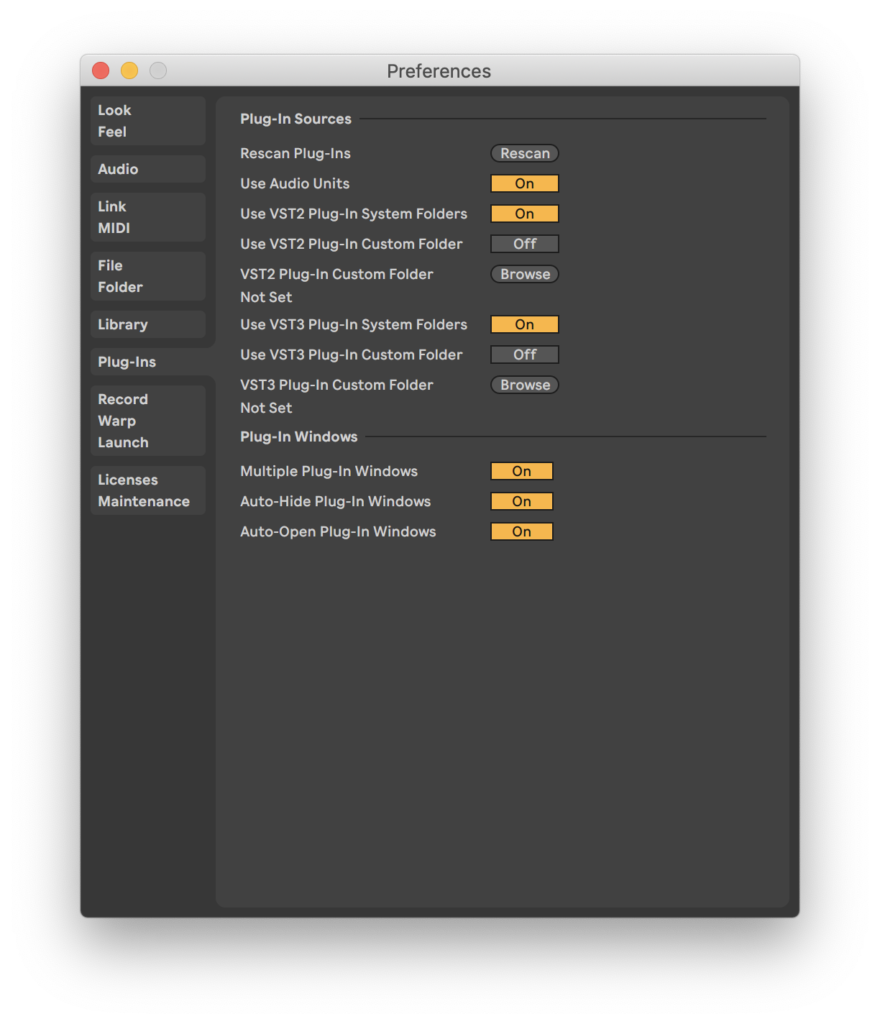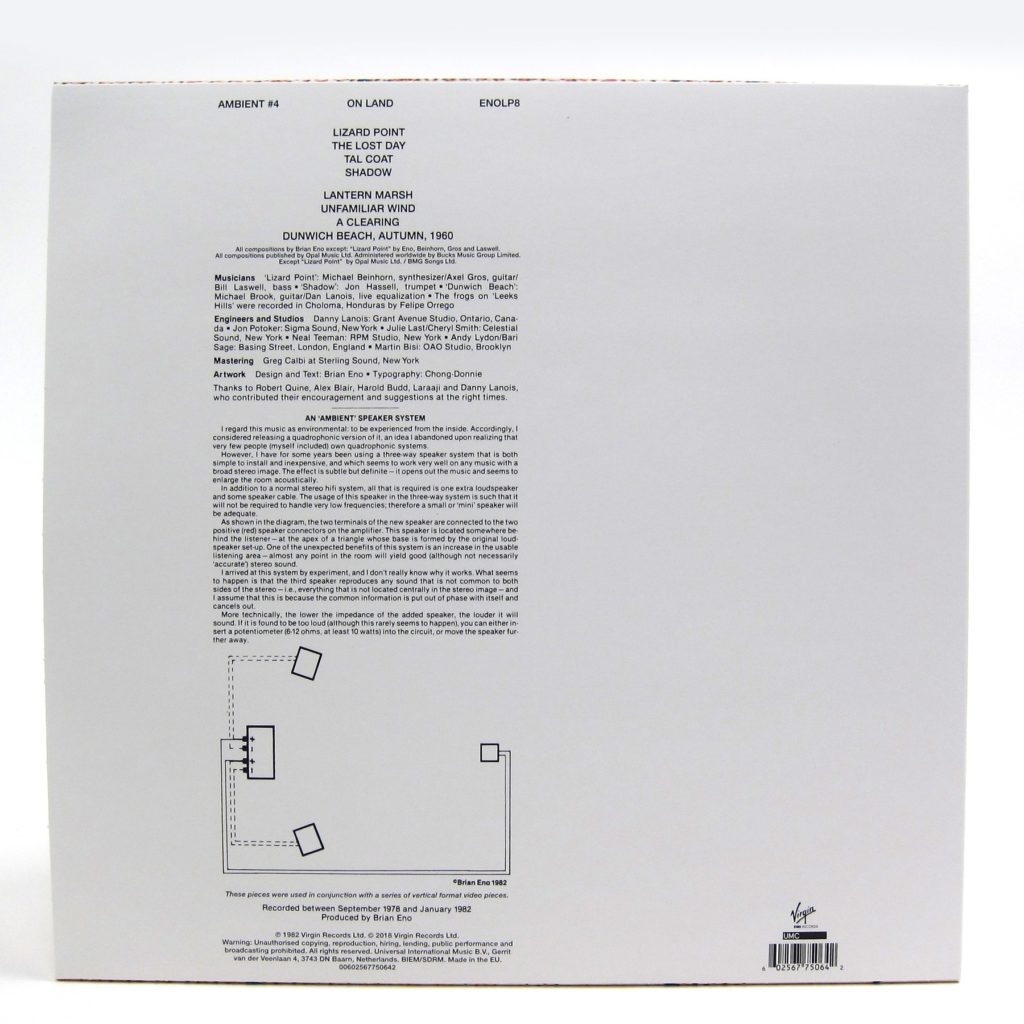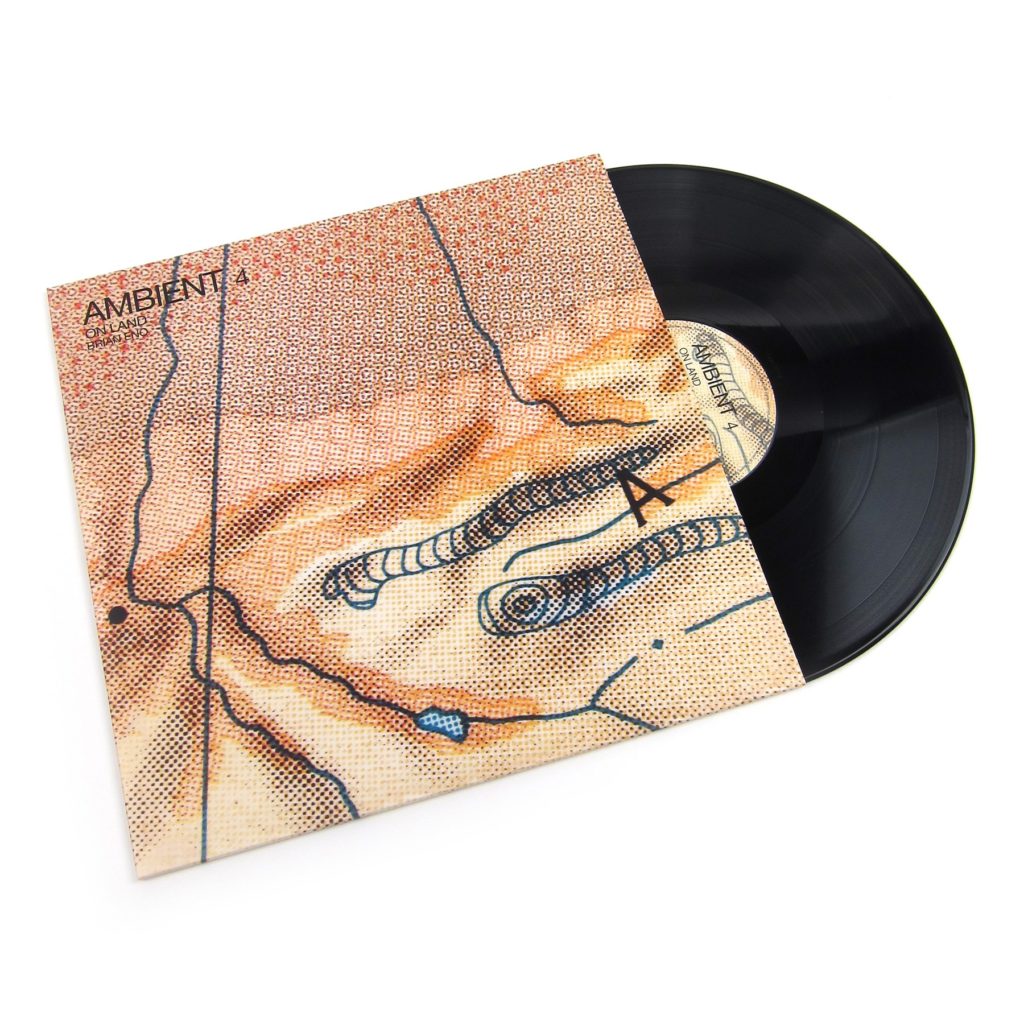First make sure that you’re using Ableton Live version 10 or newer. Past versions don’t support multi-channel audio.
Next, you may need to turn on “Use Audio Units” in the “Plug-ins” section of the Ableton Live preferences. It usually is not turned on by default… and though we have a VST3 version of QUARK, Ableton Live doesn’t play nice with it for some reason. Please use the AU version.

QUARK is based on the 1970s Sansui QS Regular Matrix format. We based most of our work on the 1974 AES whitepaper. There are many popular releases mostly from the 1970s. This website has a pretty complete list. The ones that are relevant to this format of quad are labeled “QS” on this page. Some of these releases also have alternate stereo mixes but many were only released in QS. The beauty of the format is you don’t NEED to have separate mixes.
One of the QUARK developers recently produced the first quadraphonic vinyl release in 30 years with Suzanne Ciani’s LIVE Quadraphonic. Work on that record is what lead to the development of QUARK. Impulse Records famously exclusively used the QS format for a period of time. The sad thing is most of these releases aren’t properly labeled. For instance there is a beautiful piece by Michael White in this format.
Pink Floyd’s “Dark Side of the Moon” is an example of a recording that had both a stereo and a quad mix. To further confuse things, it was done in the competing SQ format. Someone re-encoded the song “Money” in the QS format.
January through February 2021 we hosted a national call for quadraphonic work called Make Music in Space. Here are the submissions.
In addition to vintage and modern (by Involve Audio or Dolby) hardware decoders, you can listen to these songs in quad using the “decode” function of QUARK by routing the audio from your playback browsers through your DAW using an application like Loopback or BlackHole.
A couple of people on the Quadraphonic Quad forum used JUCE and BlackHole to build a stand alone app. Franck made a great video based on instruction from BJMarsh. Many of you probably don’t have Xcode on your computer so here is the already compiled app for download. Just use the instructions on the video starting here. You’ll also need to “Allow Microphone Access” and you also may need to do this to convince your Mac to open the app.
Also, the Stereo Lab software (by Richard Brice) is excellent for decoding spatial audio music into discrete tracks. It does all kinds of other amazing tricks too. The only difference is this software does not process in real time.
Like any mix, testing your QUARK encoded mix in mono is important. Though many folks listen in headphones these days, there are a lot of mono smart speakers like the amazon echo out there to consider. Listeners through these devices will have no issue hearing your music but it is important to test your mix in mono.
You have to be especially careful because the Regular Matrix math in QUARK (the same math from the 1970s) uses -90° and +90° phase shifts to fold rear channels into the front channels. As such, when listening in mono, rear-panned audio has some phase cancellation. Most drastically if you pan a track 100% to the center-back, the audio is completely cancelled.
Modern mixing techniques regularly have to address some of this compromise, especially when utilizing mid-side processing to “widen” a mix. Ultimately, use your ears.
- Don Buchla. He was making quad synths before there was a quad listening format.
- Suzanne Ciani is the true Diva of the Diode… most specifically in quad. Listen to everything she does and you will learn a lot. She is my #1 inspiration for all kinds of reasons.
- Morton Subotnick. SO much to learn from him as well. I love the way his brain works.
- If you can afford to master, it I suggest using QUARK to get your mix dialed then do the actual encoding with a mastering engineer. It’s worth it. They should both master your 4-channel master then take another light pass on your 2-channel QUARK encoded master. It really helps. At the very beginning of the process my friend Mr. Bonzai set up a meeting for me with the legendary Bernie Grundman who actually mastered the old quad records in the 70s. He gave me incredible advice and reconnected me with Scott Sedillo and Beno May who worked very closely with me to make the first quad vinyl in 30 years. They also happen to be amazing teachers of mine 15 year previous to this project. Amazing people, I would highly suggest working with them. If any of you mastering engineers out there want to offer a quad mastering service too, I’m happy to help. Hit me up.
- The Quadraphonic Quad forum is excellent resource. Tons of incredible people who have been listening and working in quad for decades. I met “Quad” Bob Herndon and Odaka Shuichi through this forum. Bob is a one of the largest collectors of all things quad who even introduced me to the Involve Audio folks as well as and Odaka-san who has custom built quad encoding hardware that he used to help me when I was making LIVE Quadraphonic.
- The entire team at Involve Audio team were crucial collaborators on LIVE Quadraphonic. They send over some demo encode and decode hardware that I used for much of the creation of the record. We made a custom hardware decoder together for the LIVE Quadraphonic release. They also make what I dare say is the best quad hardware decoder in existence.
- Stereo Lab software by Richard Brice is excellent for decoding spatial audio music into discrete tracks. It does all kinds of other amazing tricks too. Richard very kindly helped me years ago as I was doing research.
- Surround Discography is an excellent resource to research quad music. This person is a saint for maintaining this list.
- Vance Galloway and Naut Humon have been working in spacial sound for years and they make these incredible dome experiences. Vance was also the recording engineer for LIVE Quadraphonic. If you have a chance to go to their events, meet them or work with them, please do. They will blow your mind.
- This guy has did very good quad tutorial just after we release LIVE Quadraphonic; mostly focused on quadraphonic performance and very much worth watching.
I got a thoughtful email from Kirk Bayne who is a member of the Quadraphonic Quad community.
Kirk pointed out that with a standard stereo amplifier and 3 passive speakers, you can decode our flavor of “quad” to surprisingly good results. Of course, this is not as accurate as using QUARK or proper hardware decoders to decode quad but it works, it’s cheap and quite fun way to get (Listen to) Music in Space.
Backstory:
In 1982, Brian Eno released Ambient 4: On Land which was the final in his ambient series which began with the famous Music for Airport. On the back cover of the release he draws a diagram and explains how he “arrived at this system by accident, and I don’t really know why it works.”
Kirk said that what Eno discovered was actually very similar to one of the old quad format Dynaquad which somewhat accurately decodes the same QS/Regular Matrix encoding math we use in QUARK. This method is also known as the Hafler System.
Hafler published these ideas way back in 1970 (see page 22). The article is a good explanation of the Dynaquad/Hafler system.
According to Kirk, the Dynaquad system resurfaced in the early 1980s as an inexpensive way to decode Dolby Surround encoded (Beta HiFi, VHS HiFi) movie soundtracks and Kirk sent along a link to this PDF of a 1984 article which on page 63 has an article titled “Surround Sound for less than $5.”
At minimum, this is a fun experiment… and if Eno’s in, I’m in. Time to get the old speakers and amp out of storage!

Brian Eno – Ambient 4: On Land (back) with diagram. 
Brian Eno – Ambient 4: On Land (front)
We are working on a new version compatible with the M1 processor however for now there is a work around by opening your application in Rosetta Mode. Follow these instructions on how to install Rosetta and set your DAW to open in Rosetta.
The QUARK software plugin is used in Digital Audio Workstations (DAWs) and similar platforms to encode four channels of discrete audio into two channels (standard stereo) audio then back four channels again, allowing the distribution of four-channel spatial recordings via widely accessible two-channel formats such as vinyl, radio, streaming video such as YouTube and music services such as iTunes and Spotify. QUARK enables musicians, filmmakers and engineers to make spatial sound work via two channel distribution formats in the Regular Matrix format then monitor audio at the pre-encode, encode and decode phases so that these creatives may mix and master spatial sound work for distribution. QUARK is based on the 1970s Sansui QS Regular Matrix format. We based most of our work on this 1974 AES whitepaper. One of the QUARK developers recently produced the first quadraphonic vinyl release in 30 years with Suzanne Ciani’s “LIVE Quadraphonic”. Work on that record is what lead to the development of QUARK. After years of research, the QS format was the best performing matrixed spacial audio format, having a strong balance between spatial accuracy both when listening to the decoded quad audio and when listening in standard two channel playback. There is also a strong community of quadraphonic enthusiasts who prefer the QS format; one of the “LIVE Quadraphonic” collaborators Involve Audio even produces an incredible modern hardware decoder called the Surround Master. One of the most surprising discoveries is that the Dolby Pro Logic II (DLP2) format is very closely modeled after the Regular Matrix format. DLP2 is nearly universally installed in nearly every surround sound capable receiver/processor since 2001.
